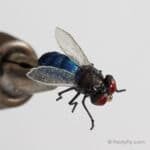Hemingway’s Stonefly Selection of 10 Assorted Flies
A truly great selection of Hemingway’s realistic stoneflies. These flies are an authentic representation of the real, live insect. They have the shape, size and coloring of a live stonefly. Tied with Hemingway’s top quality materials. The wings are transparent, flexible and soft. The flies are lightweight and they float great.
This stonefly selection comes with 10 flies of assorted colors and hook sizes #8, #10, #12, #14.
Please note that photos of fly sets are for illustration purpose only. These are assorted sets. Actual product may vary from photograph.
Stoneflies
Stonefly is an aquatic insect from the order Plecoptera. These are one of the oldest insect species, with over 3500 different varieties and can be found around the globe, everywhere except Antarctica. They love clean environments and their presence indicates very high water quality. Through their life time, stoneflies go through incomplete metamorphosis. They go from egg, to nymph and straight to adult, without the pupal or dun stages. Complete stonefly life cycle lasts anywhere from one year (for smaller species – yellow sallies) to three years (larger kinds – salmonflies and large golden stones).
Four major subspecies of stoneflies that are most significant for fly fishing are:
- Salmonfly, family Pteronarcyidae
- Large Golden Stone, family Perlidae
- Yellow Sally, family Perlodidae, subfamily Isoperlinae, genus Isoperla (Stripetail)
- Skwala, family Perlodidae (Springflies)
To learn more details about stonefly life cycle, different stonefly species, their characteristics, times of hatching, tips on fishing for each species and other great info – check out our blog post here.
Fly Fishing Stonefly Dry Patterns
There are two instances when adult stoneflies can become food for trout: near the water’s edge, just after they emerge and when they accidentally fall into the water, and secondly, and maybe most significant for a fly fisherman, is the moment of the egg-depositing, taking place on the riffles. When fishing the recently emerged adults along the river’s bank, the best technique would be dead-drifting float, tightly against the banks, beneath the overhanging branches. Should you notice that trout is ignoring your fly, try the occasional twitch – it can entice a strike as it could appear more natural to the trout underneath.
For fishing the riffles, when egg-depositing starts, usually in the evening, dead-drift is again the best presentation to utilize. However, to best imitate the natural behavior of the fly when they deposit eggs, an occasional hop or twitch could make a huge difference. Many stonefly females make a big splash when they hit the water and some continue to flutter while depositing their valuable load. Successfully imitating this behavior can entice the fish and bring you that big strike. Cast the fly hard to make a splash and produce a commotion. Having your fly skate or skitter across the river’s surface might do the trick.























Reviews
There are no reviews yet.